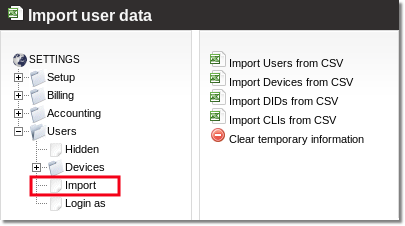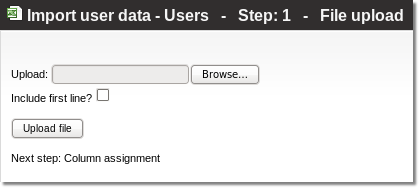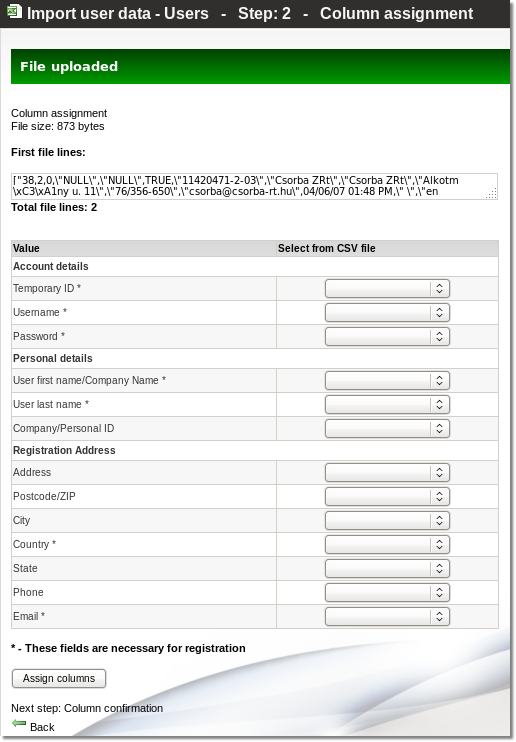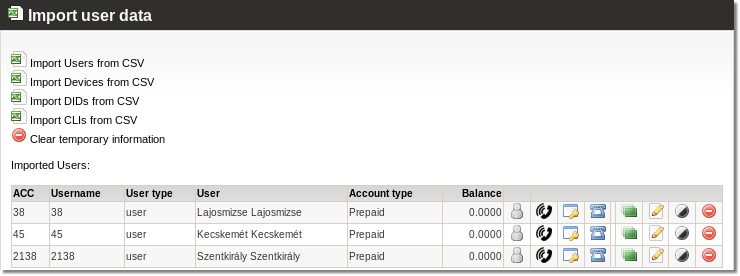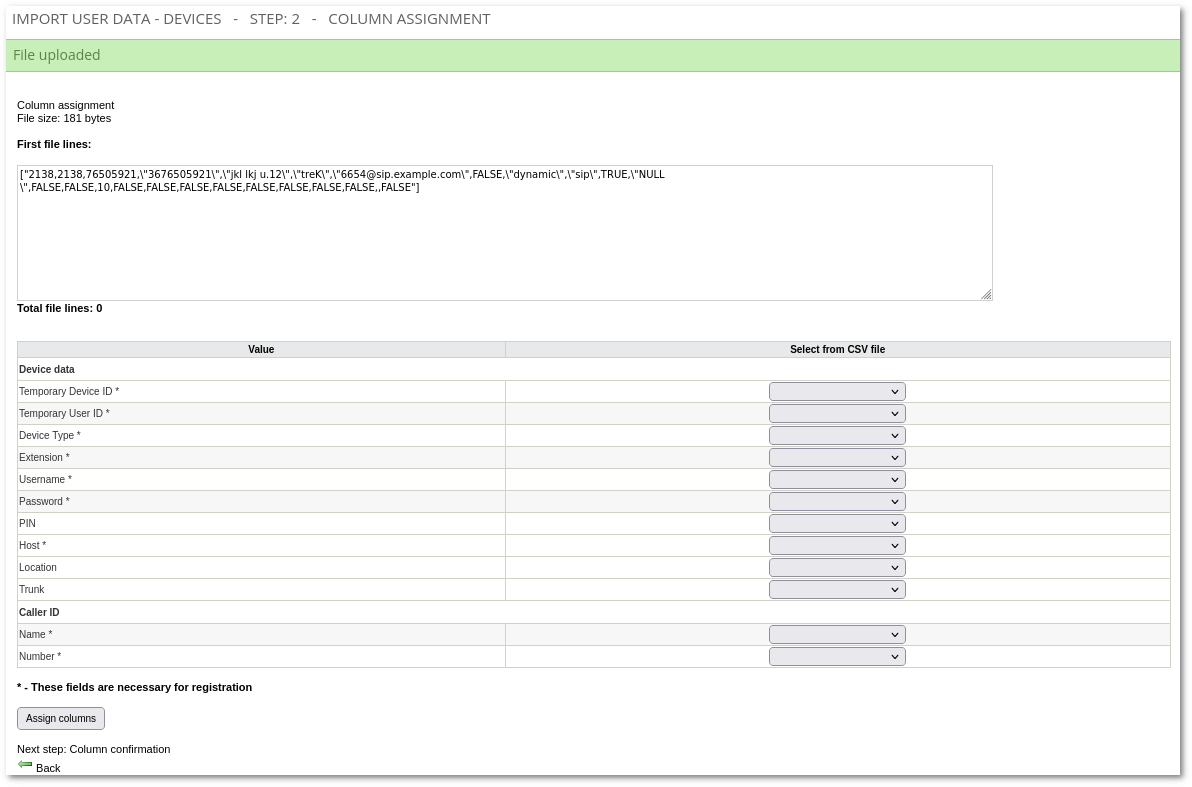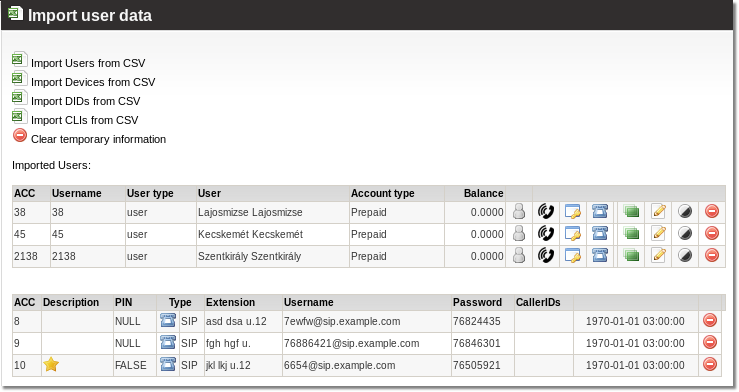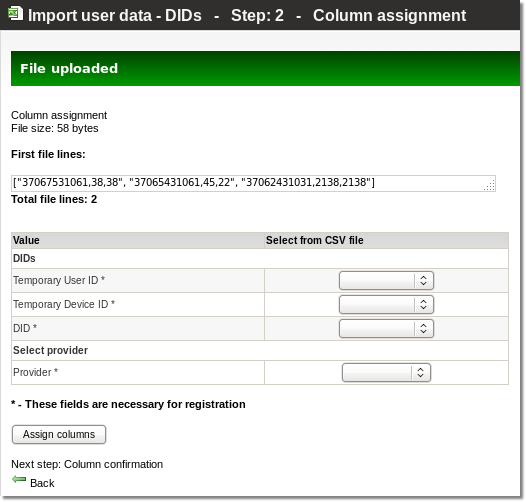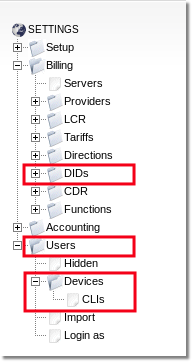Data import
User/Device/DID import
You must import the data in the following order from CSV files:
1. Users data
2. Devices data
3. DIDs data
CSV file format
Here you can download Excel file with necessary headers which should be filled prior importing data into MOR.
You can upload your data from a CSV file, which has the following structure:
1. Each record is started in a new line.
2. Each piece of record information is separated with commas (see the example).
3. Text is enclosed with inverted commas (example: "name")
4. Numbers are written without inverted commas (example: 4)
5. First line can be used for your own needs, like for naming each field of information. If you do so - do not select "include first line?" option when asked.
For example:
We have a csv file named example.csv with contents in it:
"id","username","password","e-mail"
1,"username1","verySecretPassword","example@example.com"
2,"username2","34r34r4232","example2@example.com"
3,"username3","23er29923wjwe","example3@example.com"
Explaination:
The first line I used here was for naming the fields, so when asked do not select "include first line?" option (if you won't use the first line for naming the fields, when please select "include first line?")
Other 3 lines (starting 1,2,3) are for data records. Each record (the first one is: 1,"username1","verySecretPassword","example@example.com") represents:
1 - user id
"username1" - user's username
"verySecretPassword" - user's password
"example@example.com" - user's e-mail
Your CSV file can have any number of lines with any number of fields (each line must have the same number of fields).
P.S. The file should not have any other symbols, except those stated before. Be careful, as some editors can add their own formatting symbols. In windows we recommend to use notepad, in linux: gedit, kedit, nano.
Here are some examples:
dids csv file example:
37067531061,38,38
37065431061,45,22
37062431031,2138,2138
In this example the first column I have used for did, second for Temporary User Id and the third for Temporary Device ID. Your data order can be completely differrent, you just need to select correct values when asked.
users csv file example:
38,2,0,"NULL","NULL",TRUE,"11420471-2-03","Example ZRt","Example ZRt","example example. 11","76/356-650","example@example.hu",04/06/07 01:48 PM," ","en",97,20,0,FALSE,TRUE,5,0,04/06/07,"NULL","NULL",0,FALSE,04/06/07,"Lajosmi",6050,1,0,1,1,TRUE,"NULL","NULL",3
45,2,0,"95757bfa00bf85b17921d709b5af0234","NULL",TRUE,"12969247-2-03","Example Ákos","Example Example, Kft","Example's 38","70/235-45-89","example@example2.hu",04/06/09 11:28 AM," ","en",97,20,0,FALSE,TRUE,5,0,04/07/09,"NULL","NULL",0,FALSE,04/06/09,"Kecexample",6000,1,0,1,1,TRUE,"NULL","NULL","NULL"
2138,2,0,"cc1b3ae8986559b10786d6ea73912bd5","NULL",TRUE,"11871633-2-03","Kos Tas","Ks Kft","Alsó ast","20/229-36-78","pli@example.hu",12/13/07 09:42 AM," ","en",97,20,0,FALSE,TRUE,5,0,12/13/07,"NULL","NULL",0,FALSE,12/13/07,"Sirly",6031,1,0,1,1,TRUE,"NULL","NULL","NULL"
In the first column here is a Temporary User's ID, other columns represent other data. As mentioned before it does not matter in which order your data is represented in csv file, it only matters that each column (the data between comma's) would represent the same data value (id,email, password or other... )
devices csv file example:
38,38,76824435,"3676586421","asd dsa u.12","jamaica","7ewfw@sip.example.com",TRUE,"dynamic","sip",TRUE,"NULL","NULL","NULL","NULL","NULL","NULL","NULL","NULL","NULL","NULL","NULL","NULL","NULL","NULL"
45,45,76846301,"3676886421","fgh hgf u.","ergerSiP","76886421@sip.example.com",TRUE,"dynamic","sip",TRUE,"NULL","NULL","NULL","NULL","NULL","NULL","NULL","NULL","NULL","NULL","NULL","NULL","NULL","NULL"
2138,2138,76505921,"3676505921","jkl lkj u.12","treK","6654@sip.example.com",FALSE,"dynamic","sip",TRUE,"NULL",FALSE,FALSE,10,FALSE,FALSE,FALSE,FALSE,FALSE,FALSE,FALSE,FALSE,,FALSE
The first column here represents "id", second "user_id", others represent other data. YOUR ORDER CAN BE DIFFERENT. The main thing is, that each type of data: email, password, id... must be in the same column. When you will be asked to provide data when importing - you will assign correct data from csv for each column and MOR will know which column which data represents.
Importing data
Firstly from MOR Grafical User Interface (later: GUI) navigate to: Settings -> Users -> Import, as in the picture:
Temporary User ID & Temporary Device ID
These fields are necessary to map DIDs to Devices and Devices to Users.
Example:
You have some other system with some user_ids, device_ids, did_ids. You export them into CSV files. Relation between them are kept by these IDs, so importing them to MOR will keep these relations.
First you need to import User with some temporary ID then make sure this ID is near each Device you are trying to import. And select this ID as Temporary User ID when importing Devices. That way these devices will be mapped to this User.
Importing users
To import users click on "Import Users from CSV" link:
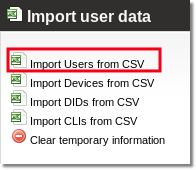
Now please locate the csv file in your local system by clicking the "Browse" button. As stated before don't press on "Include first line?" checkbox if you have used the first line for commenting the fields.
Click on "Upload file" button.
In next menu please fill the requested data (you should select the correct field from your csv file). You must select a field for each selection box marked with an asterisk (*) symbol. Having finished press the "Assign columns" button.
In next page check whether all data was assigned correctly, if not - press the "Back" button and correct the mistakes. If all the data was assigned correctly - press the "Confirm columns" button. After you will be informed that columns are assigned with "Columns assigned" notifacation, press "Back to M enu" button. Having done all these steps - you should see a page, similar to this:
Importing devices
Click on the "Import Devices from CSV" link and do the same step for uploading a csv file as in "import users" section, thats: Locate the csv file in your local system by clicking the "Browse" button. As stated before don't press on "Include first line?" checkbox if you have used the first line for commenting the fields. Click on "Upload file" button. Now you should see a menu similar to this:
In this menu once again select a matching field from your csv file for each selection box. It is very important, to correctly select Temporary User ID and Temporary Device ID, because these fields are necessary to map DIDs to Devices and Devices to Users.
Having finished selecting the fields press the "Assign columns" button.
Once the columns are assigned, check whether all data is correct, if not, press the "Back" button and correct the mistakes. Press "Back to Menu" button, now if you haven't done any mistakes you should see 2 tables, similar to these:
Importing DIDs
Click on the "Import Devices from CSV" link and do the same step for uploading a csv file as in "import users" section, thats: Locate the csv file in your local system by clicking the "Browse" button. As stated before don't press on "Include first line?" checkbox if you have used the first line for commenting the fields. Click on "Upload file" button. Now you should see a menu similar to this:
Select all matching field from your csv here. It is very IMPORTANT to select CORRECT Temporary User ID and Temporary Device ID! Having everything correctly selected press "Assign columns" button. In the next page if all imported data is assigned correctly press the "Confirm columns" button. If you haven't done any mistakes - now you should see a "DIDs created" message.
Success!
Now you can go to check whether all your data was imported:
To check users, go to: Settings -> Users
To check devices, go to: Settings -> Users -> Devices
To check DIDs, go to: Settings -> Billing -> DIDs
